HIL E4
This room is a lecture hall with 256 seats and has an area of 300 m².
In my opinion, this lecture hall offers the best acoustics.
The sound is clear with no echo, making the conferences easy to listen to. The sound is crisp and concise, with no noticeable reverb, regardless of where you sit in the room. Background noise (people talking, writing sounds, etc.) is overpowered by the speaker’s voice.
The sound feels warm and lush, and the room is open and acoustically balanced.


Audio recording
– 0,5 m from audio recorder
– 2 m from audio recorder
– 5 m from audio recorder
– 10 m from audio recorder
– 0,5 m behind audio recorder
– 3 m behind audio recorder
HIL F61
The second room is HIL F61. This is an indoor room, split into three parts: two partitioned spaces with wooden panels and an emergency exit passageway. The two partitioned areas are used for course projects, facilitating group work and studio instruction.
This is an interesting place because when there is noise, it is very hard to understand anything. The wooden panels don’t block the noise but actually increase sound reverberation.
There are several sources of sound: a guest or professor giving a lecture to a large group of people, group discussions involving several people talking together, and smaller group discussions. These discussions don’t always happen at the same time, as there are two studios in the same area. In addition to studio discussions, there is noise from the passageway and the sound of the ventilation system.
When a certain number of people are present, there is always a constant hum or murmur, making conversations very difficult, especially when you are far from the speaker. It’s the same for group discussions, where it’s challenging to locate speakers and understand what they are saying.
The sound feels boomy, echoey, and reverberant. I would describe the space as a noisy room full of buzzing and hissing.

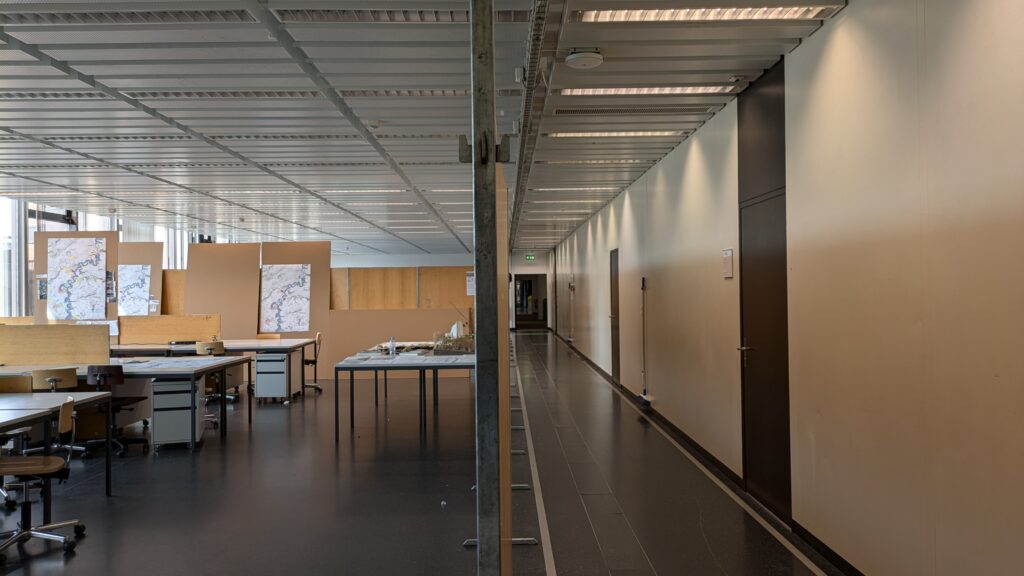
Audio recording
– 0,5 m from audio recorder
– 2 m from audio recorder
– 5 m from audio recorder
– 10 m from audio recorder
– 0,5 m behind audio recorder
– 2 m behind audio recorder
2 Exploring the Emotional Impact of Everyday Sounds
Stefano-Franscini-Platz
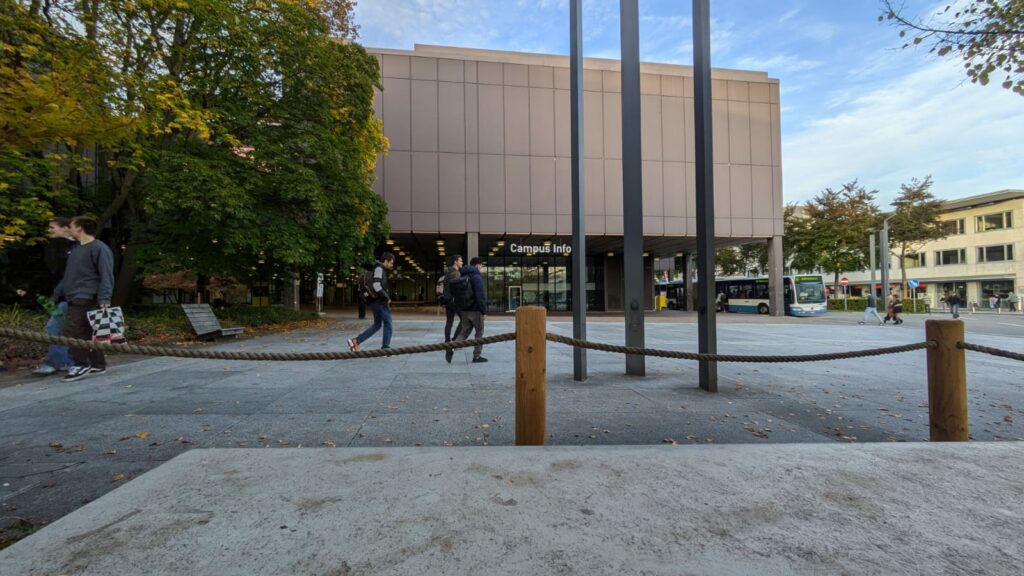
The first place is Stefano-Franscini-Platz, specifically on a concrete table, 15 meters from Wolfgang-Pauli-Strasse. From this road, you can hear traffic noise at more or less regular intervals, due to the passage of buses. The intensity of the sounds varies depending on the size of the bus (whether it’s articulated or not) and its type (Zurich public transport or ETH Link). Moreover, the sound changes depending on the direction the bus is going. When some buses brake, the tires screech, producing a particularly high-pitched noise. On this road, you can also hear the sound of bicycle pedals.
This square is also filled with concrete tables and benches. Since the weather was pleasant, most of the tables were occupied. Sometimes, you can make out conversations in English or German, but most of the time, there’s just an indistinct hum of people talking. Certain sounds stand out, such as the crinkling of sandwich paper, the unfolding of aluminum foil, the opening of an aluminum can, the screeching of Velcro, or the rustling of a bag against a jacket. The ground is covered with gravel and fallen leaves, and you can hear the footsteps of people, as well as the crunching of the gravel underfoot.
Opposite, there is a paved area that people walk across, their steps echoing more deeply and distinctly. In that area, there is also a food truck, from which the sound of coins clinking can sometimes be heard.
Other sounds appear more randomly and are less localized: someone running, a light breeze, an airplane passing overhead, and distant hammering of metal.
Altstetterplatz
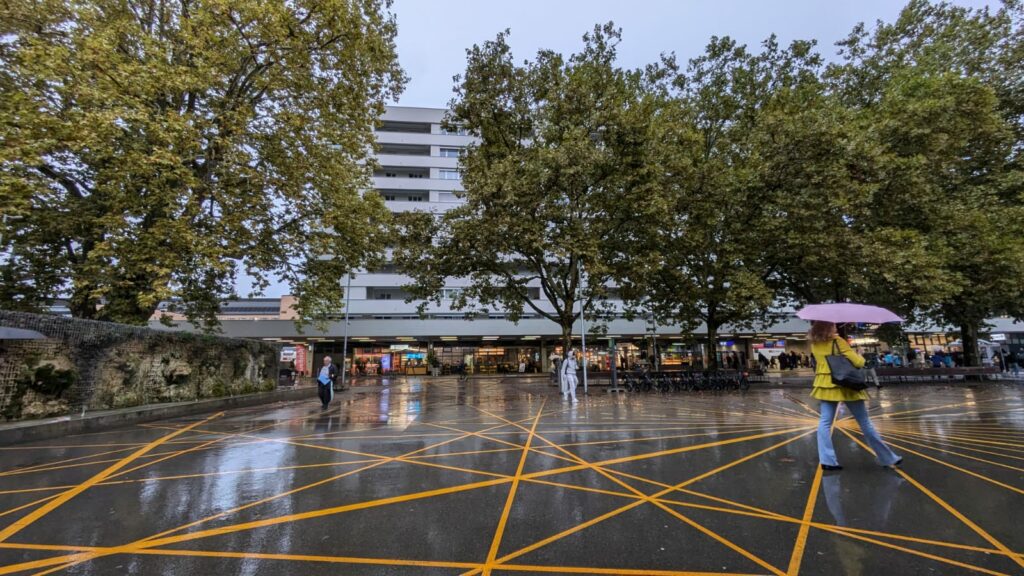
The second place is a bus stop, with a road behind me. A square about thirty meters across stretches in front, with a lot of foot traffic leading to the underpass that provides access to the platforms. The square is paved, surrounded by relatively tall buildings, and there are five trees about fifteen meters tall scattered around.
It’s raining, and the sound of the rain is loud and continuous. Traffic on the road is also heavy. You can hear different types of vehicles: buses, cars, and a few trucks, with the sounds of tires screeching, brakes, and accelerations. The buses make louder noises as they stop at the bus stop, and the sound of their doors opening can be heard. Occasionally, a car horn blares.
The screeching of a train braking on the tracks can also be heard at regular intervals. People crossing the square produce intermittent, less persistent noises: footsteps, people running to catch a train, rolling suitcases, or bicycles. Occasionally, you hear a phone ringing.
Other sounds related to waiting for a bus or train also appear: conversations, laughter, a video being played aloud on a speaker, a bag being dropped heavily on a bench, a can being opened, or the sound of an umbrella unfolding.
Most emergent sounds: The hum of people talking and the sound of rain.
Most catchy sounds: The sound of cans opening and aluminum foil crinkling.
Most likely overheard sounds: The buses stopping.
Emotional state and overall perception of the situation :
In the first situation, the hammer blows echoed at a rather high frequency, which produced an unpleasant feeling. This sensation was also amplified because the sound was distant, and you couldn’t see where it was coming from. Despite the noise of people nearby, a silence was felt when the hammering stopped. The hum of people around me quickly made me feel a sense of confinement, as it surrounded me on all sides. In the second situation, the sound of the rain was heavy and made the atmosphere rather sad, even though this feeling was also due to the absence of sunlight and the rain itself. The other sounds that interrupted the rain seemed almost cheerful to me.
Sound volume, frequency, and context and emotional responses :
High-frequency sounds are unpleasant, and their cessation brings relief and a feeling of silence, despite the ambient noise. The volume of a sound is not a decisive factor when considered individually. Cars and buses produced a loud but short sound. It was rather the repetition of these sounds that caused some discomfort. The context also plays an important role in either absorbing or amplifying certain sounds, but also in the overall atmosphere, with feelings of confinement despite the absence of walls in the first case, or a sense of gloom caused by the sound of the rain and, by extension, the rain itself.
What sounds would cause discomfort ? :
An animal’s cry, partly because their cry is their only response to pain, but also due to the empathy I feel. Or a simple high-frequency sound, this kind of sound can make me shiver
What sounds would alert you ?
Sounds that are loud and unusual in a silent context.
3 Empirical and numerical estimation of room acoustic properties
HIL E4

RT60 = 0,505 x 2 = 1.01s
Estimation of the reverberation time
500 Hz
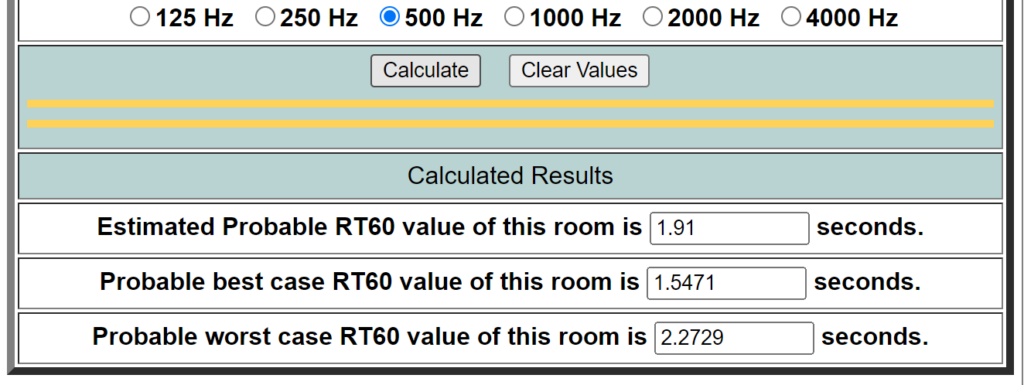
1000 Hz
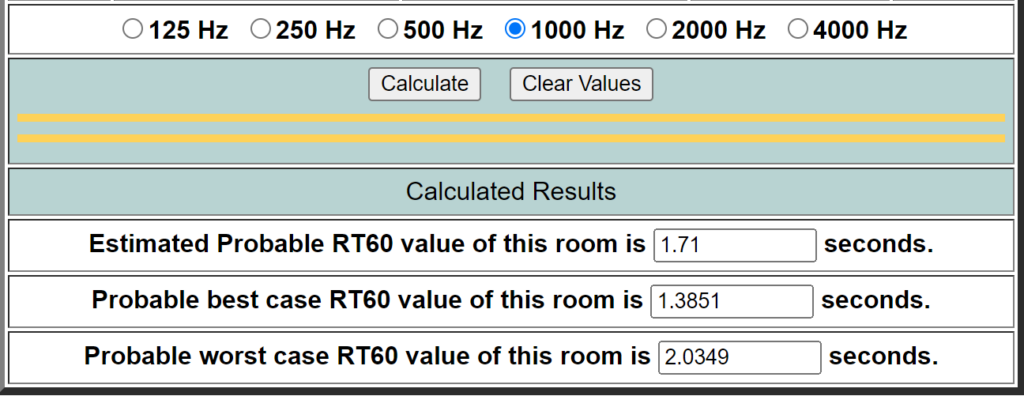
I have a few reservations about these estimates, the shape of the room, for example, is not a rectangle, whereas in the program I had to pretend it was. Or the orientation of the wall panels, which is not parallel to the wall. All these elements, among many others, influence the reverberation time, but are not taken into account in the estimate.
HIL F61

RT60 = 0,437 x 2 = 0,874s
Estimation of the reverberation time
500 Hz

1000 Hz

The estimation of the reverberation time is also complicated, as the HIL F61 room is complex to model in the simulator, notably due to the wooden panels that partition the room without completely separating it. However, the measurements seem consistent with the results from the HIL E4 room. The reverberation time is about twice as long, which confirms the auditory impression.
The RT60 calculation seems strange to me because the reverberation time is shorter than that of the first room. My theory is that the audio recording was unable to capture the end of the reverberation due to the surrounding noise, which distorts the data needed for the calculation.
4 Characterization of room acoustic treatments
HIL F61
The ceiling of the room is designed to incorporate all the sound-absorbing elements. It consists of three types of components: sound absorbers measuring 150 x 20 x 10 cm, with wider variants measuring 50 cm across. Lights are integrated into this system, positioned every four elements. Each module is spaced 10 cm apart, forming a regular grid of panels that provide visual harmony. The elements are perforated with small holes that “trap” sound and absorb high frequencies.
Several pieces of furniture also contribute to sound diffusion within the room, including tables, chairs, and wooden panels. Although tables and chairs likely have a minimal acoustic impact, the wooden panels function more as reflectors. The room has a rectangular shape, with concrete walls that reflect sound. To allow flexibility in the room’s layout, it is difficult to place absorbers in specific locations. Therefore, they have been installed in the ceiling, where they integrate well into the room’s architecture, harmoniously incorporating the lighting.

HIL E4
Auditoriums generally have more advanced acoustic treatment than other types of rooms. Absorbers are installed throughout: from carpet on the floor to wooden wall panels, which have holes to trap sound and shapes that “break” sound reflections. The ceiling, too, is designed to diffuse sound randomly, reducing echoes.
The regular rows of seating also contribute to sound reflection, but in an irregular way, as do the people sitting, whose clothing creates additional reflective surfaces. The room’s geometry is designed to promote good acoustics: the height of the ceiling reduces reflections by increasing the distance of sound travel, and the arrangement of non-parallel surfaces helps to limit excessive reverberation. Each element is crafted to optimize listening and make the acoustic experience enjoyable. Together, they form a coherent architectural design, creating a pleasant atmosphere that is well-integrated into the room.

Object sound
The chosen object is a Swiss knife, specifically its bottle opener, which can be deployed and folded back.
The knife, along with its mechanism, is made of stainless steel, or inox. With each opening, the distinct click of the mechanism resonates with a clear and precise sound.
This familiar sound is somewhat comforting, because I’ve gotten into the habit of opening and closing it regularly to keep my hands busy while I work.
5 Full Picture
The room is H HIL F61. This is an indoor room, split into three parts: two partitioned spaces with wooden panels and an emergency exit passageway. The two partitioned areas are used for course projects, facilitating group work and studio instruction.
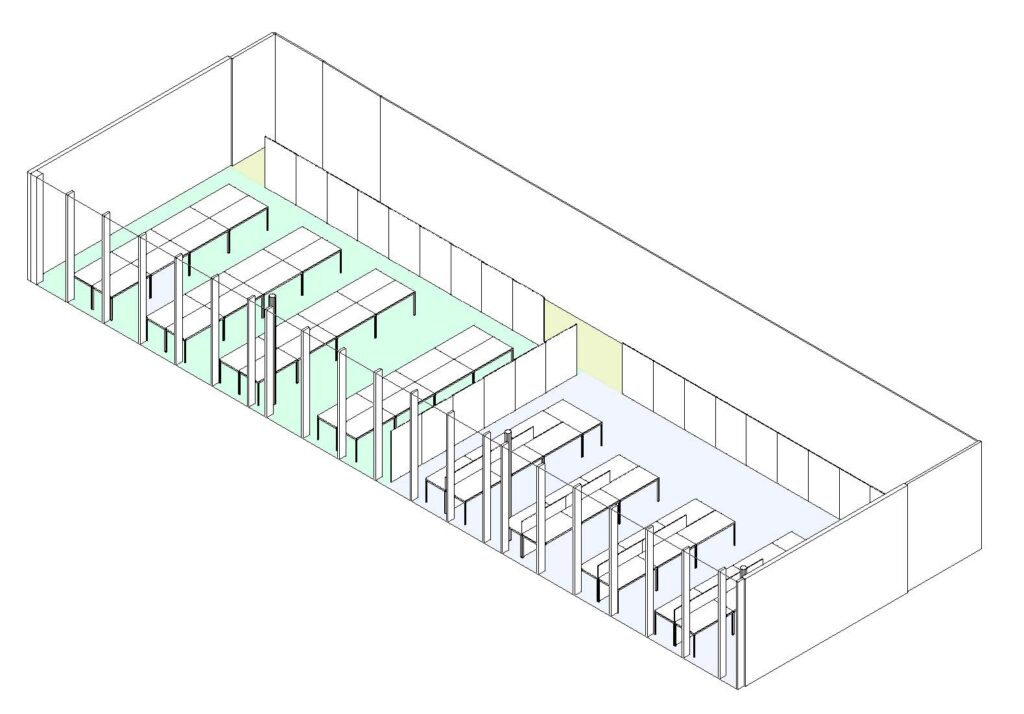
There are several sources of sound:
- ponctual noise from the passageway
- sound of the ventilation system.
- a guest or professor giving a lecture to a large group of people
- group discussions involving several people talking together
- smaller group discussions.
The discussions don’t always happen at the same time, as there are two studios in the same area and sound and their reflection interfere with each other.
According to the standards set by the State Secretariat for Economic Affairs (SECO) of the Confederation, in this type of space, the sound level must not exceed 65 dB. Depending on the size of the room, a reverberation time of 1.5 seconds is considered appropriate. Since these values cannot be achieved without sound absorbers, it was decided to install some. To maintain the flexibility required for this type of space, these sound absorbers were placed on the ceiling.
It consists of three types of components: sound absorbers measuring 150 x 20 x 10 cm, with wider variants measuring 50 cm across. Lights are integrated into this system, positioned every four elements. Each module is spaced 10 cm apart, forming a regular grid of panels that provide visual harmony. The elements are perforated with small holes that “trap” sound and absorb high frequencies.

Reverberation time online calculator

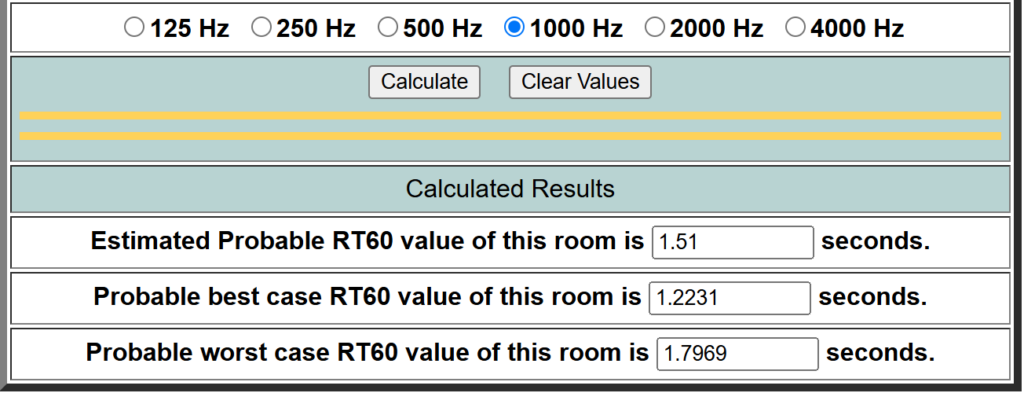
Reverberation time simulation with Rhinoceros 3D, Grasshopper and Pachyderm Acoustic Simulation
62,5 Hz : 1.715145 seconds
125 Hz : 1.755773 seconds
250 Hz : 1.761241 seconds
500 Hz : 1.687586 seconds
1000 Hz : 1.592004 seconds
2000 Hz : 1.489842 seconds
4000 Hz : 1.176319 seconds
8000 Hz : 1.875807 seconds
Simulation sound dispersion
Sound is reflected not only by the walls, floor, and ceiling of the room, which are arranged in a parallel configuration, but also by the furniture within the space. The wooden panels used to partition the different areas actively contribute to sound reflection. Tables also play a role in this process, as do chairs, the room’s occupants, and their clothing. However, the latter have a lesser impact due to their relatively low density.
The materials of the surfaces, along with the room’s typology, result in a reverberation time close to 1.5 seconds or slightly above, which exceeds the standards set by SECO. The room quickly becomes noisy, boxy and reverb-y. This is clearly noticeable in the audio recordings simulated with Rhinoceros 3D and Pachyderm Acoustic.
The first recording is a lecture captured directly at the source. The sound is clear and understandable.
The second recording incorporates the room’s reverberation, with a receiver placed 5 meters away and at a 15° angle to the right. The sound becomes more challenging to understand: it is cavernous and resonant.
The third recording includes additional noise sources, notably a conversation in the other part of the room and the sound of ventilation. The ventilation and conversation create an indistinct but very present noise, making the lecture harder to follow and requiring greater focus to understand.
The fourth recording simulates unilateral deafness on the left side.
The fifth recording adds hearing loss to the left ear. The lecture then seems more distant, and distinguishing sounds becomes more difficult. Focused attention is needed to discern the words and follow the content of the lecture.
Improving the acoustics of this room while preserving its characteristics is difficult. This is often the issue with flexible and open spaces. A typical solution to reduce reverberation would be to rethink how the space is used, but here, it’s complicated due to the three groups of users. For instance, if the room were dedicated to a single activity, it would avoid simultaneous discussions among multiple groups. Closing off the corridor could also help reduce noise from foot traffic, and adjusting the ventilation could limit certain sound disturbances.
Adding more acoustic absorbers is also not straightforward. The wooden panels, necessary for displaying drawings during presentations, cannot be replaced. Even if absorbers were added, they would quickly be covered with paper, rendering them ineffective.
An intermediate solution could be the use of sound-absorbing curtains. This would provide more flexibility while partially isolating the different areas. It’s an option often implemented after realizing that the acoustics are problematic. However, these curtains are more effective at high frequencies and do not constitute a complete solution.
This is the option that will be explored here.
Reverberation time simulation with Rhinoceros 3D, Grasshopper and Pachyderm Acoustic Simulation
62,5 Hz : 1.595709 seconds
125 Hz : 1.239503 seconds
250 Hz : 0.97607 seconds
500 Hz : 0.761965 seconds
1000 Hz :0.788055 seconds
2000 Hz : 0.745948 seconds
4000 Hz :0.671348 seconds
8000 Hz : 0.614611 seconds
With this improvement, the reverberation time is below the standard, except at low frequencies, where there is still an improvement. At certain frequencies, the improvement in reverberation time is even around 1 second.
The lecture is significantly more understandable thanks to the curtains, which effectively absorb background noise. While this noise remains slightly perceptible, it does not impact overall comprehension. Low frequencies resonate a bit more, whereas the resonance of high frequencies is well reduced.
These curtains are a corrective solution implemented after identifying the room’s acoustic issues. Ideally, acoustics should have been considered from the outset by incorporating them directly into the architectural design. This is, of course, a challenge for this type of flexible space, both in terms of room layout and the variety of functions it accommodates.



